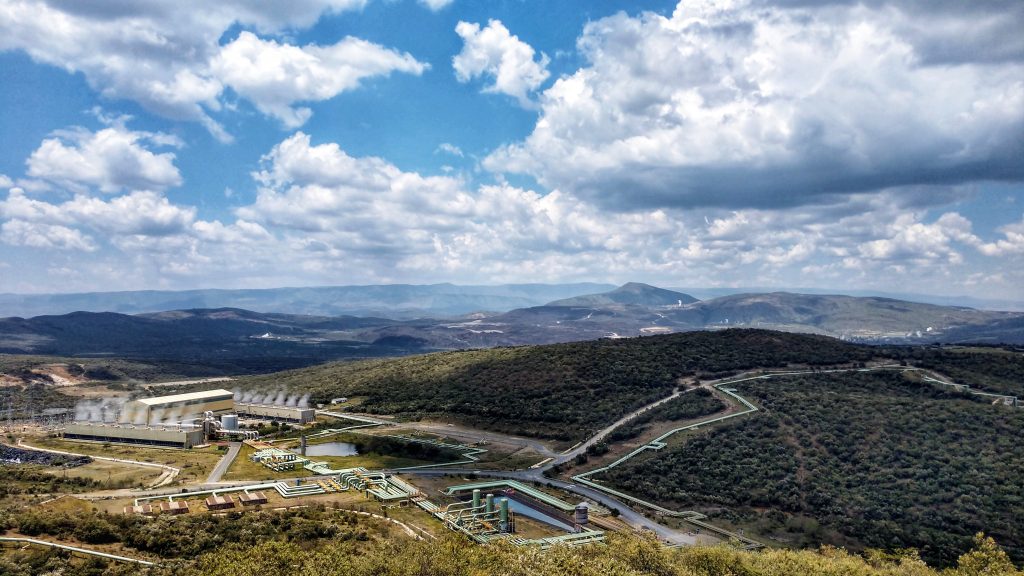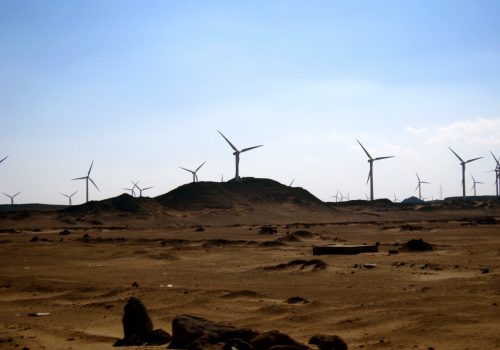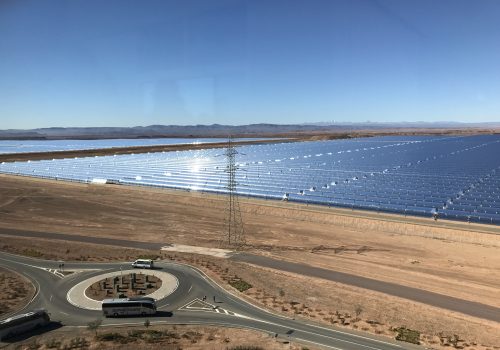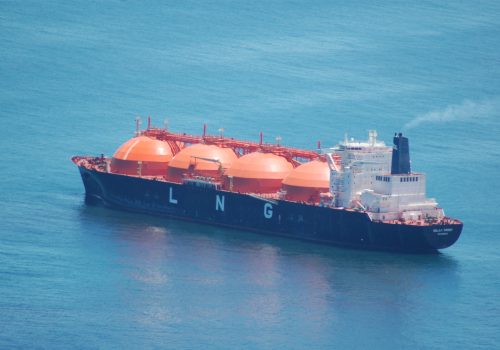Breakthroughs at COP27 led to greater international support for the MENA region’s unique potential for producing cost-effective green hydrogen. Multiple financing agreements and strategic partnerships between MENA states and potential European buyers signaled the region’s interest in long-term cooperation on developing hydrogen infrastructure and production capacity.
As Europe drives investment into the MENA region, green hydrogen’s potential in sub-Saharan African nations like South Africa, Namibia, and Kenya risks being overlooked as a driver of needed sustainable energy and economic development. Partially due to the effects of COVID-19, the population without access to electricity in sub-Saharan Africa rose in 2020 for the first time since 2013. Currently, the region accounts for 77 percent of the global population without access to electricity, up from 74 percent prior to the pandemic. Energy demand is set to rise dramatically over the next 30 years, as the region’s current population of 1.18 billion is expected to double to over 2.2 billion by 2050.
But supporting sub-Saharan sustainable energy development is not only a pressing facet of a just global energy transition; it would also be a mutually beneficial investment decision. The average long-term practical yield for a photovoltaic solar energy installation in the region is 4.34 kWh/kWp/day, significantly higher than Europe’s 3.44 kWh/kWp/day. Nearly 30 percent of the region is capable of producing over 5 kWh/kWp/day of photovoltaic output, with some of the strongest concentrations of solar irradiation in Namibia, South Africa, Botswana, and Ethiopia. Sub-Saharan wind energy potential is also strong, particularly along the coasts of Namibia, South Africa, and Kenya. If successfully developed, renewable energy capacity could produce economically viable green hydrogen in Africa under €2 per kilogram by 2030.
South Africa signaled its intention to develop green hydrogen at scale with the release of the South African Hydrogen Society Roadmap (HSRM) in February 2022. The HSRM outlined four catalytic demonstration zones designed to lay the groundwork for long-term decarbonization of industry and transportation as well as the creation of a robust export market for green hydrogen and green ammonia.
In cooperation with Hydrogen Council members Anglo American and ENGIE, South African private and public sector operators are pursuing the development of a centralized hydrogen valley known as the Platinum Valley Initiative (PVI). The valley aims to connect three hubs—Johannesburg, Durban, and Limpopo—with a projected aggregated demand of 184 kilotons (kt) of green hydrogen by 2030. The initial viability study projected that the PVI could add between $4-9 billion to South African GDP by 2050 in addition to creating between 14,000-30,000 direct and indirect jobs annually. The nine currently proposed projects would contribute to decarbonization efforts spanning the transport, industrial, and mining sectors.
In addition to HSRM and PVI, South Africa signed a Just Energy Transition Partnership (JETP) agreement with France, Germany, the United Kingdom, and the United States in November 2021. At COP27, US Special Presidential Envoy for Climate John Kerry and South African President Cyril Ramaphosa announced the endorsement of the $8.5-billion JETP investment plan. Expanding the transportation and energy potential of green hydrogen is a key component of the investment strategy.
To the west, Namibia is also expanding its development goals for green hydrogen with a focus on Southern Corridor Development Initiative (SCDI). Following the hydrogen valley model, the SCDI is a partnership between the Namibian Green Hydrogen Council and the German firm Hyphen Hydrogen Energy. The project is expected to produce 300,000 tons of green hydrogen by 2030 from 5-6 gigawatts (GW) of installed renewable energy capacity. The Namibian Port Authority (Namport) is a critical component of the SCDI scheme, already laying the groundwork with Hyphen and the Port of Rotterdam to identify needed export infrastructure.
Before an export market can develop, however, Namibia’s existing energy woes must be addressed. In 2022, only 56 percent of Namibians had access to electricity, and the nation imported 60-70 percent of its electricity demand. Hyphen says its planned projects will generate 1.5-2 terawatt-hours of surplus electricity per year, nearly equal to Namibia’s purchases from the South African Power Pool (SAPP) regional electricity network. Hyphen’s development contract is only a fraction of the 26,000 square kilometers reserved by the government for green hydrogen development. As more projects are announced, renewable energy costs will decrease, and additional electricity supply should be available to both meet domestic demand and contribute to the decarbonization of the SAPP.
Already leading the continent in geothermal energy capacity, Kenya announced a slate of investment partnerships on the sidelines of COP27 for the growth of an East African green hydrogen hub. Fortescue Future Industries (FFI), an Australian firm with a global green hydrogen and ammonia portfolio, won the rights to develop a 300-megawatt (MW) green hydrogen and ammonia plant over the next three years.
Kenya’s development of renewable energy capacity has been a blessing for the country, nearly doubling electricity access from 32 percent in 2013 to 75 percent in 2022. Kenya Electricity Generating Company’s (KenGen) geothermal infrastructure is responsible for 70 percent of that growth, and the state-owned firm announced an additional $2-billion investment in new geothermal plants in 2021. As geothermal energy continues to expand, new solar and wind projects can exclusively produce green hydrogen and its derivatives without shortchanging residential, commercial, or industrial electricity demand.
As electrolyzer costs continue to decrease and sub-Saharan Africa’s renewable energy capacity grows, developing a robust green hydrogen and ammonia economy across the region could serve as an economic and energy development boon. Before that vision can be achieved, however, the inequities between nations and energy networks within the region must be addressed through cooperation and international support. Of the forty-eight countries in the region, twenty-four have electricity grids which service less than half of their national populations; eight have grids which reach less than 20 percent of citizens. This broad range of energy system reach complicates viability assessments for green hydrogen and other sustainable energy sources when focusing on sub-Saharan Africa as a whole. Instead, development potential in specific nations like South Africa, Namibia, and Kenya should be the focus of near-term support, with the goal of expanding successful programs and investments across the region over the next 30 years.
As sustainable energy markets develop in regional leaders throughout the decade, regional partnerships like the African Green Hydrogen Alliance should expand their membership. Angola, Mozambique, Botswana, Tanzania, and Ethiopia all possess reasonable wind and solar resources and form a corridor along the southern and eastern coasts of Africa, a prime opportunity for domestic development of green hydrogen and export to Asian buyers.
Regional leaders should pursue strategies to support the expansion of electricity grids and sustainable energy in neighboring nations. Adapting previous strategies like the Mozambique Transmission Company’s (MOTRACO) cross-border interconnection project—which linked transmission networks from South Africa, Mozambique, and Eswatini for aluminum smelting—may be a way to connect large-scale utility grids, which would bolster each nation’s ability to produce cost-effective green hydrogen on a consistent basis. International financing agreements like Just Energy Transition Partnerships (JETPs) or initiatives like Power Africa should support the long-term goal of leveling electricity access and energy networks across the region, building from lessons learned from existing agreements with South Africa. While concrete strategies for developing sustainable energy in energy-insecure sub-Saharan countries remain undefined, identifying early avenues of support is a critical step in harnessing the potential 50 million tons of regional green hydrogen capacity by 2035, according to a recent report from the European Investment Bank.
Kenya, Namibia, and South Africa are well positioned to expand their production capacity over the next ten years while gradually expanding green hydrogen markets to neighboring nations and setting the foundation for future export markets to Europe and Asia. If done correctly, the African Green Hydrogen Alliance partners could set favorable regulatory environments for the region and leverage their supply on international markets. Green hydrogen has unique potential to fuel the sustainable development of the transportation networks, industrial bases, and commercial enterprises of sub-Saharan nations while also strengthening their relationship with international trading partners.
Daniel Helmeci was a Summer 2022 Young Global Professional at the Atlantic Council Global Energy Center.
Related content
Learn more about the Global Energy Center

The Global Energy Center develops and promotes pragmatic and nonpartisan policy solutions designed to advance global energy security, enhance economic opportunity, and accelerate pathways to net-zero emissions.
Image: The Olkaria geothermal field in Kenya. (Greg Rhodes, Geothermal Rising, Flickr, CC BY-NC-ND 2.0) https://creativecommons.org/licenses/by-nc-nd/2.0/




